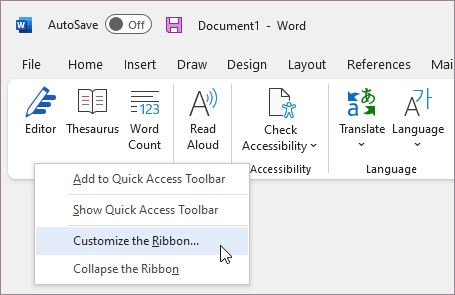


Any other global template add-ins (in alphabetical order) This means if you want a "global" customization to appear in Word 2013 but NOT Word 2010 (and vice versa), you will need to open and create a customized QAT in the appropriate version's Normal.dotm.īonus Tip: QAT icons are arranged according to the following protocol:
#WORD FOR MAC 2016 CUSTOMIZE TOOLBAR UPDATE#
Both versions will share and update the same Word.customUI file. Note: If you have both Word 20 installed on your computer. Data for template\document specific customizations are stored in a CustomUI file that is part of the template Open Office XML File Format file.Data for global QAT customizations for Word 2010 "AND" Word 2013 is stored in a file named "Word.customUI." Data for global QAT customizations for Word 2007 is stored in a file named "Word.qat." These files are typically found at "C:\Users\Your User Name\AppData\Local\Microsoft\OFFICE." Replace "Your User Name" as appropriate.QAT customizations can be global (available in all documents) or template\document specific. Note: For tips on adding a custom command (or macro) to the QAT and selecting one of the available button face images see my: Add a Macro to the Quick Access Toolbar (QAT) Modifying QAT For technical assistance contact EndNote Technical Support.This Microsoft Word Tips & Microsoft Word Help page will show you how you can modify the button icons or icon label text displayed on your global or template\document specific customized Quick Access Toolbar (QAT)Īdditionally, you can use the techniques shown here to modify the button icons displayed on your ribbon customized using the Word 2010 or 2013 built-in user interface.įor reasons unknown, Microsoft provided a limited collection of icons (180) to use for QAT customization and more regrettably it first appeared that they didn't want users to have any flexibility to change the default button image assigned to the built-in commands. Change Word Preferences so it will not automatically open up the document gallery (which can prevent EndNote from connecting)Īs a last resort, try reinstalling EndNote.Select the folder Applications:Microsoft Office 2011:Office:Startup:Word and click Choose Make sure the Startup folder is set by highlighting Startup and clicking on Modify.Start Word, go to Word > Preferences and click on File Locations.Go to the folder Applications:Microsoft Office 2011:Office:Startup:Word and paste the copied file.Copy the file EndNote CWYW Word 2011.bundle.Open your hard drive and go to the folder: EndNote X-: Applications:EndNote X-:Cite While You Write.Then open Word and check the Tools menu for the EndNote submenu. Click next until the Customizer is finished. Check the box in front of the Cite While You Write option. Open EndNote, and go to the EndNote menu.If that does not work, try the following: To restore Macintosh EndNote Tools in Word 2011 :įirst, try rebooting your computer.

#WORD FOR MAC 2016 CUSTOMIZE TOOLBAR PATCH#
The patch will become automatically available after successful installation of X7. NOTE: There was a compatibility issue with EndNote X7 and the MacIntosh OS Sierra which has been corrected in the latest version X8.Ī Cite While You Write patch is available for EndNote X7 that addresses the compatibility issue with Office 2016/Office 365 on Macintosh .


 0 kommentar(er)
0 kommentar(er)
